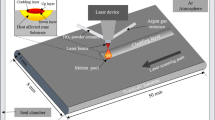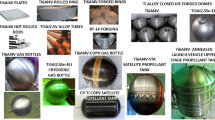Abstract
In order to enhance the tribological properties of titanium (Ti), a gradient structure with a nanocrystalline surface layer was formed on the surface of the UNS R50400 (Gr2/TA2/CP3) Ti discs by means of ultrasonic surface rolling processing (USRP). The microstructure and microhardness of the USRP and untreated Ti were investigated. The tribological properties of the USRP Ti under both vacuum and atmospheric conditions were examined in comparison with the untreated Ti using a ball-on-disc vacuum tribometer. The results showed that an ultrafine-grained (UFG) deformation layer with a thickness of 200 μm was produced on the USRP Ti, and its mean surface grain size was refined to about 38 nm from 45 μm. The surface hardness of the USRP Ti is 310 HV, which is about 2.3 times that of the untreated Ti. Additionally, the USRP Ti possesses a lower friction coefficient and higher wear resistance under vacuum conditions than untreated Ti. Under atmospheric conditions, USRP Ti shows more extensive oxidation wear and milder abrasive wear compared with the untreated Ti. Under vacuum conditions, because of the formation of the UFG deformation layer, USRP Ti exhibits a significant decrease in plastic deformation and adhesive wear compared with the untreated Ti.













Similar content being viewed by others
References
Schutz, R.W., Watkins, H.B.: Recent developments in titanium alloy application in the energy industry. Mater. Sci. Eng. A 243, 305–315 (1998)
Schutz, R.W., Baxter, C.F., Boster, P.L.: Applying titanium alloys in drilling and offshore production systems. JOM 53(4), 33–35 (2001)
Smith, J.E., Schutz, R.W., Bailey, E.I.: Titanium-drill pipe development for short-radius drilling. J. Petrol. Technol. 52(5), 50–53 (2000)
Eylon, D., Seagle, S.R.: Advances in titanium technology: an overview. J. Jpn. Inst. Light Met. 50(8), 359–370 (2000)
Magnani, P.G., Re, E., Ylikorpi, T., Cherubini, G., Olivieri, A.: Different drill tool concepts. Acta Astronaut. 59, 1014–1019 (2006)
Navarathinam, N., Lee, R., Borschiov, K., Quine, B.: Northern light drill for Mars: performance evaluation. Acta Astronaut. 68, 1234–1241 (2011)
Finzi, A.E., Lavagna, M., Rocchitelli, G.: A drill-soil system modelization for future Mars exploration. Planet. Space Sci. 52, 83–89 (2004)
Magnani, P.G., Re, E., Ylikorpi, T., Cherubini, G., Olivieri, A.: Deep drill (DeeDri) for Mars application. Planet. Space Sci. 52, 79–82 (2004)
Miyoshi, K.: Aerospace mechanisms and tribology technology—case study. Tribol. Int. 32(11), 605–616 (1999)
Miyoshi, K.: Considerations in vacuum tribology (adhesion, friction, wear, and solid lubrication in vacuum). Tribol. Int. 32(11), 673–685 (1999)
Salama, M.M., Murali, J., Joosten, M.W.: Titanium drilling risers—application and qualification. J. Offshore Mech. Arct. 122(1), 47–51 (1999)
Qin, Y.B., Dou, Y.H., Wang, X.Z., Yang, J.W.: Development of the ring block drill pipe casing wear tester and experimental research. Adv. Mater. Res. 634–638, 3582–3585 (2013)
Talalay, P.G.: Subglacial till and bedrock drilling. Cold Reg. Sci. Technol. 86, 142–166 (2013)
Zhu, X.H., Liu, S.H., Tong, H.: Comparative study of drill pipe erosion wear in gas drilling and mud drilling. Appl. Mech. Mater. 34–35, 1708–1712 (2010)
Radziszewski, P., Laplante, R., De Ciccio, P.: Approximating diamond drill rod wear. CIM Bull. 95, 93–96 (2002)
Liu, S.H., Zheng, H.L., Zhu, X.H.: Drill string failure analysis and erosion wear study at key point for gas drilling. Energy Explor. Exploit. 32(3), 553–568 (2014)
Zhu, X.H., Liu, S.H., Tong, H., Huang, X.B., Li, J.: Experimental and numerical study of drill pipe erosion wear in gas drilling. Eng. Fail. Anal. 26, 370–380 (2012)
Yu, L., Zhang, L.B., Fan, J.C.: Influence of iron ore powder and barite on the friction and wear behavior of casing and drill pipe pair. J. Tribol. 24(5), 462–466 (2004)
Zacny, K., Cooper, G.: Considerations, constraints and strategies for drilling on Mars. Planet. Space Sci. 54, 345–356 (2006)
Lebedeva, I.L., Presnyakova, G.N.: Adhesion wear mechanisms under dry friction of titanium alloys in vacuum. Wear 148(2), 203–210 (1991)
Liu, Y., Yang, D.Z., He, S.Y., Wu, W.L.: Microstructure developed in the surface layer of Ti6Al4V alloy after sliding wear in vacuum. Mater. Charact. 50, 275–279 (2003)
Zhecheva, A., Sha, W., Malinov, S., Long, A.: Enhancing the microstructure and properties of titanium alloys through nitriding and other surface engineering methods. Surf. Coat. Technol. 200, 2192–2207 (2005)
Valiev, R.: Nanostructuring of metals by severe plastic deformation for advanced properties. Nat. Mater. 3, 511–516 (2004)
Estrin, Y., Vinogradov, A.: Extreme grain refinement by severe plastic deformation: a wealth of challenging science. Acta Mater. 61, 782–817 (2013)
Gao, N., Wang, C.T., Wood, R.J.K., Langdon, T.G.: Tribological properties of ultrafine-grained materials processed by severe plastic deformation. J. Mater. Sci. 47(12), 4779–4797 (2012)
Styarov, V.V., Shuster, L.S., Migranov, M.S., Valiev, R.Z., Zhu, Y.T.: Reduction of friction coefficient of ultrafine-grained CP titanium. Mater. Sci. Eng. A 371, 313–317 (2004)
La, P.Q., Ma, J.Q., Zhu, Y.T., Yang, J., Liu, W.M., Xue, Q.J., Valiev, R.Z.: Dry sliding tribological properties of ultrafinegrained Ti prepared by severe plastic deformation. Acta Mater. 53, 5167–5173 (2005)
Wang, C.T., Gao, N., Mark, G.G., Wood, R.J.K., Langdon, T.G.: Effect of grain size on the micro-tribological behavior of pure titanium processed by high-pressure torsion. Wear 280–281, 28–35 (2012)
Purceka, G., Saray, O., Kul, O., Karaman, I., Yapici, G.G., Haouaoui, M., Maier, H.J.: Mechanical and wear properties of ultrafine-grained pure Ti produced by multi-pass equal-channel angular extrusion. Mater. Sci. Eng. A 517, 97–104 (2009)
Lu, K., Lu, J.: Surface nanocrystallization (SNC) of metallic materials presentation of the concept behind a new approach. J. Mater. Sci. Technol. 15, 193–197 (1999)
Lu, K., Lu, J.: Nanostructured surface layer on metallic materials induced by surface mechanical attrition treatment. Mater. Sci. Eng. A 375–377, 38–45 (2004)
Wang, T., Wang, D.P., Liu, G., Gong, B.M., Song, N.G.: Investigations on the nanocrystallization of 40Cr using ultrasonic surface rolling processing. Appl. Surf. Sci. 255, 1824–1829 (2008)
Liu, Y., Wang, L.J., Wang, D.P.: Finite element modeling of ultrasonic surface rolling process. J. Mater. Proc. Technol. 211, 2106–2113 (2011)
Huang, L., Lu, J., Troyon, M.: Nanomechanical properties of nanostructured titanium prepared by SMAT. Surf. Coat. Technol. 201(1–2), 208–213 (2006)
Wen, M., Wen, C., Hodgson, P.D., Li, Y.C.: Tribological behavior of pure Ti with a nanocrystalline surface layer under different loads. Tribol. Lett. 45, 59–66 (2012)
Ma, G.Z., Xu, B.S., Wang, H.D., Chen, S.Y., Xing, Z.G.: Excellent vacuum tribological properties of Pb/PbS film deposited by Rf magnetron sputtering and ion sulfurizing. Appl. Mater. Interfaces 6, 532–538 (2014)
She, D.S., Yue, W., Fu, Z.Q., Gu, Y.H., Wang, C.B., Liu, J.J.: The effect of nitriding temperature on hardness and microstructure of die steel pre-treated by ultrasonic cold forging technology. Mater. Des. 49, 392–399 (2013)
Paschke, H., Weber, M., Kaestner, P., Braeuer, G.: Influence of different plasma nitriding treatments on the wear and crack behavior of forging tools evaluated by Rockwell indentation and scratch tests. Surf. Coat. Technol. 205, 1465–1469 (2010)
Fillot, N., Iordanoff, I., Berthier, Y.: Wear modeling and the third body concept. Wear 262, 949–957 (2007)
Godet, M.: The third-body approach: a mechanical view of wear. Wear 100, 431–452 (1984)
Fillot, N., Iordanoff, I., Berthier, Y.: Modelling third body flows with a discrete element method—a tool for understanding wear with adhesive particles. Tribol. Int. 40, 973–981 (2007)
Landolt, D., Mischler, S., Stemp, M., Barril, S.: Third body effects and material fluxes in tribocorrosion systems involving a sliding contact. Wear 256, 517–524 (2004)
Ma, C., Wang, S.C., Wang, L.P., Walsh, F.C., Wood, R.J.K.: The role of a tribofilm and wear debris in the tribological behavior of nanocrystalline Ni–Co electrodeposits. Wear 306, 296–303 (2013)
Wang, H.D., Ma, G.Z., Xu, B.S., Si, H.J., Yang, D.X.: Microstructure and vacuum tribological properties of 1Cr18Ni9Ti steel with combined surface treatments. Surf. Coat. Technol. 205, 3546–3552 (2011)
Ma, G.L., Yang, J.Q., Liu, Y., He, S.Y., Jiang, Z.H.: Friction and wear behavior of nanocrystalline nickel in air and vacuum. Tribol. Lett. 49, 481–490 (2013)
Nouari, M., Iordanoff, I.: Effect of the third-body particles on the tool–chip contact and tool-wear behaviour during dry cutting of aeronautical titanium alloy. Tribol. Int. 40, 1351–1359 (2007)
Iordanoff, I., Seve, B., Berthier, Y.: Solid third body analysis using a discrete approach: influence of adhesion and particle size on macroscopic properties. J. Tribol. 124(3), 530–538 (2002)
Zmitrowicz, A.: Wear debris: a review of properties and constitutive models. J. Theor. Appl. Mech. 43(1), 3–35 (2005)
Acknowledgments
The authors are grateful for the financial support from the National Natural Science Foundation of China (51375466), Beijing Higher Education Young Elite Teacher Project (YETP0646), Beijing Natural Science Foundation (3132023), Fundamental Research Funds for the Central Universities (2652013080) and Tribology Science Fund of State Key Laboratory of Tribology (SKLTKF13B10). The authors would like to thank Prof. Haidou Wang and Dr. Guozheng Ma from the National Key Laboratory for Remanufacturing, Academy of Armored Forces Engineering, for their help with the use of the vacuum tribometer.
Author information
Authors and Affiliations
Corresponding author
Rights and permissions
About this article
Cite this article
She, D., Yue, W., Du, Y. et al. Vacuum Tribological Properties of Titanium with a Nanocrystalline Surface Layer. Tribol Lett 57, 1 (2015). https://doi.org/10.1007/s11249-014-0447-4
Received:
Accepted:
Published:
DOI: https://doi.org/10.1007/s11249-014-0447-4




